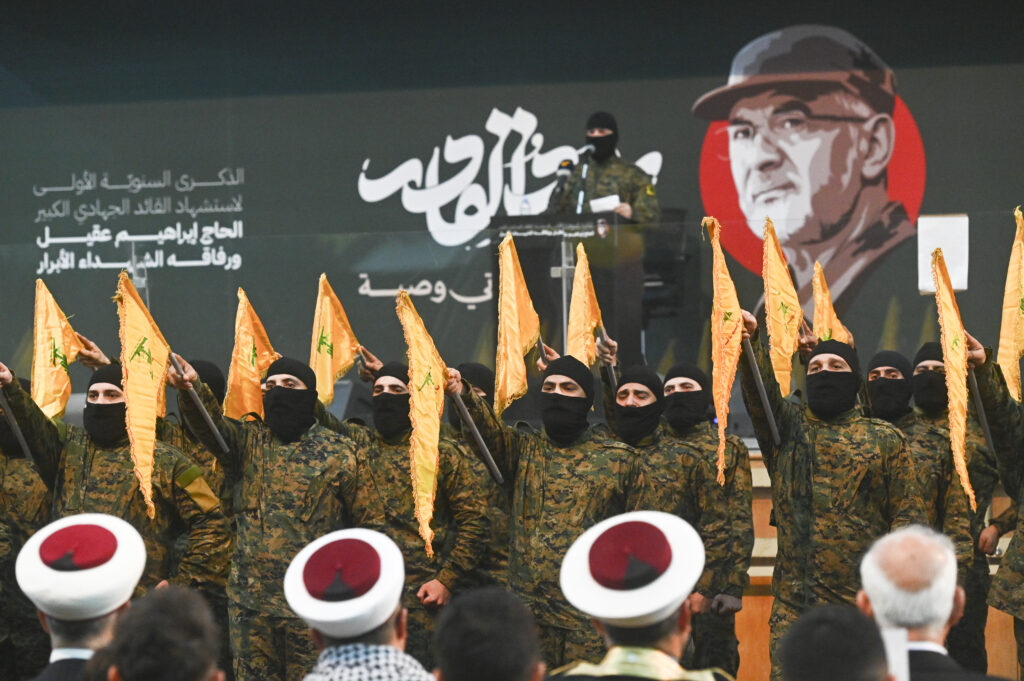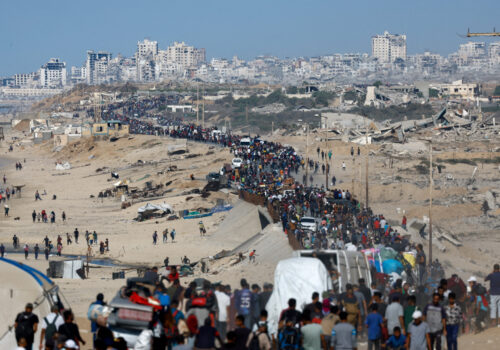As the international community’s focus remains fixed on the Gaza Strip, Israel’s northern front is quietly reigniting. Nearly a year has passed since the November 2024 cease-fire between Israel and Hezbollah took effect, yet its core terms remain unfulfilled. While the agreement has muted Hezbollah’s immediate threat, it has by no means eliminated it. In response, Israel has stepped up operations against Hezbollah activity in southern Lebanon.
This escalation comes as senior US officials have warned the Lebanese government that its failure to uphold central provisions of the November 2024 cease-fire would lead to “grave” consequences. As tensions approach a boiling point, Israel must internalize the lessons of its October 7 security failures to ensure that no hostile actor can again pose an existential threat to the Jewish state.
Hezbollah’s return to the battlefield
Israeli officials report dwindling patience as they near a decision point on the northern front. On October 30, Prime Minister Benjamin Netanyahu and Defense Minister Israel Katz held a “special consultation” to discuss the Israeli response to Hezbollah’s ongoing violations. This follows calls by US Special Envoy for Syria Tom Barrack for Hezbollah’s immediate disarmament and reports that the United States is no longer convinced by Lebanese President Joseph Aoun’s claims that disarming the group is impossible. Barrack’s demands signal a hardening US stance on the issue: If Lebanese forces are not deployed to the south, Hezbollah is not disarmed, and direct negotiations with Israel are not undertaken, Israel will reserve the right to act unilaterally.
Meanwhile, Hezbollah is actively rebuilding and rearming, smuggling weapons across the Syrian border. Western intelligence officials have reportedly found that the group is replenishing its rocket stockpiles, recruiting new fighters, and restoring military sites in violation of the cease-fire agreement. Hezbollah has also shifted parts of its operations north of the Litani River to avoid confrontation with the Lebanese Armed Forces (LAF) and to subvert stipulations in UN Resolution 1701 and the November cease-fire, both of which call for the area south of the Litani to be free of non-state armed groups.
In response, Israel has stepped up its operational tempo. In recent weeks, the Israel Defense Forces (IDF) has intensified its campaign in southern Lebanon, carrying out frequent air sorties and precision strikes on Hezbollah infrastructure. Israeli officials claim that roughly 330 Hezbollah operatives have been killed since the cease-fire. Simultaneously, the IDF is conducting large-scale exercises simulating an October 7-style attack by Hezbollah.
Lebanon’s political paralysis
While the Lebanese government has made nominal efforts to disarm Hezbollah and restore a state monopoly on weapons, this objective appears largely unattainable within the parameters of the cease-fire due to Hezbollah’s political influence and the LAF’s lack of capability. Lebanon’s sectarian power-sharing system has allowed Hezbollah to become deeply embedded in national politics. Though the organization typically controls less than 15 percent of parliamentary seats, its alliances and grassroots mobilization ensure it remains a central actor in Lebanese governance.
In certain Shia communities, Hezbollah enjoys greater legitimacy than the central government. Although the Lebanese government presented an action plan to disarm the group—and Israel even agreed to scale back operations and withdraw from five outposts— Israeli and foreign sources maintain that “the road to complete disarmament is still long.” This comes as the LAF has reportedly exhausted its supply of explosives, while one Western intelligence official warned that “Hezbollah is rebuilding faster than the Lebanese army is dismantling.”
Lebanese officials contend, as Reuters put it, that “the army wants to avoid inflaming tensions and to buy time for Lebanon’s politicians to reach a consensus about the terror group’s arsenal in other parts of the country.” Hezbollah, for its part, has publicly refused to relinquish its weapons caches north of the Litani, hinting that conflict is possible if confronted by the LAF.
Avoiding the mistakes of October 7
With the LAF unable or unwilling to neutralize Hezbollah, Israel’s security establishment must integrate the lessons of October 7 into its strategic calculus as it prepares for a renewed confrontation on its border. Before that day, the IDF’s assumptions about Hamas deterrence proved fatally flawed. First, Israel fell into a mirror imaging trap. Israel assumed Hamas would act rationally as a governing entity, prioritizing the welfare of Gaza’s population and maintaining a functioning civil order. Moreover, the IDF expected periodic, limited escalations rather than a large-scale coordinated war. As a result of these assumptions, Israel pursued a “mowing the grass” strategy—frequently targeting the strip to degrade Hamas’s capabilities—which ultimately fostered complacency and a misleading sense of stability. The core lesson of October 7 is that deterrence cannot be taken for granted, and unaddressed threats inevitably metastasize into crises.
Israel must not repeat these errors with Hezbollah, even while the group appears weakened. The Israeli government cannot assume Hezbollah is deterred or constrained by domestic Lebanese politics or past fighting. Instead, the group’s rearming and rebuilding efforts are designed to threaten Israel directly and to bolster Iran’s regional deterrence strategy. Hezbollah has also likely learned from Hamas’s surprise attack and its own miscalculations during the 2024 conflict. The group likely underestimated Israel’s rapid escalation doctrine, expecting gradual tit-for-tat exchanges that would favor Hezbollah’s attritional strategy. Instead, the precision strike campaign—from the detonation of thousands of Hezbollah-linked pagers to an airstrike on Hassan Nasrallah’s underground headquarters—demonstrated Israel’s willingness to escalate rapidly and decisively. As a result, Hezbollah will likely adopt a more aggressive and risk-tolerant posture, seeking to preempt or complicate Israel’s ability to manage escalation.
Emerging from October 7 as a battle-hardened regional superpower, Israel must shift from deterrence by denial to deterrence by punishment. Lebanon’s fragile institutions appear to lack the capacity and the political will to dismantle Hezbollah. Therefore, Israel must be prepared to sustain calibrated military pressure while simultaneously building international legitimacy and regional partnerships to establish a durable security architecture in southern Lebanon. Only by combining military strength, diplomatic coordination, and strategic foresight can Israel prevent another front from exploding—and keep Hezbollah in check for the foreseeable future.
Jonathan Rosenstein is a program assistant on the Forward Defense team of the Atlantic Council’s Scowcroft Center for Strategy and Security, where he supports work on nuclear strategy and space security.
Further reading
Wed, Oct 15, 2025
Twenty questions (and expert answers) about the next phase of an Israel-Hamas deal
New Atlanticist By
What will follow part one of the cease-fire deal brokered by the Trump administration? Atlantic Council experts share their answers.
Fri, Oct 10, 2025
Why Lebanon is stuck in the middle on Hezbollah disarmament
MENASource By Nicholas Blanford
Lebanon finds itself caught between the rock of US pressure for Hezbollah’s disarmament and the hard place of Hezbollah refusing to do so.
Wed, Aug 13, 2025
What to know about the history (and future) of the Hezbollah disarmament question
MENASource By
Domestic opposition and international demands have brought the question of Hezbollah’s arms to the fore, placing the group in an increasingly precarious position.
Image: Hezbollah supporters gather to listen to the speech of Hezbollah Secretary-General Naim Qassem on the first anniversary of the death of the commander-in-chief of Hezbollah's special operations unit, Ibrahim Aqil, who dies in an Israeli strike on September 20, 2024, in the southern suburb of Beirut, Lebanon, on September 19, 2025 (Photo by Fadel Itani/NurPhoto).NO USE FRANCE




